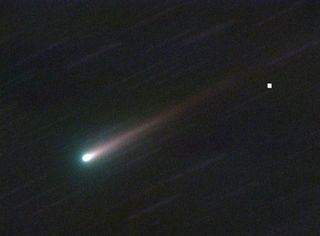Rosetta Spacecraft's Comet Water Discovery: What It Means for Earth

Where did Earth's water come from? Comets? Asteroids?
New data from the Rosetta spacecraft exploring Comet 67P/Churyumov-Gerasimenko show that comets — once thought responsible for seeding Earth with water — might not have delivered most of the planet's water after all. The new finding is giving scientists a more nuanced view of the solar system and its plethora of cosmic bodies.
An instrument called ROSINA on the European Space Agency's Rosetta has found that the molecular makeup of the water on Comet 67P/C-G is very different from the water found in Earth's oceans. This deuterium-to-hydrogen ratio throws a hitch into the theory that comets from Comet 67P/C-G's region of space brought water to the Earth not long after the solar system formed, Kathrin Altwegg, principal investigator for ROSINA, said. [See comet images from Rosetta]
If even a small number of comets like 67P/C-G impacted Earth in the early days of the solar system, it still would have greatly changed the molecular composition of the planet's water today, according to Altwegg. Therefore, it seems unlikely that these kinds of comets brought water to Earth. Altwegg thinks it's more probable that asteroids brought water to Earth.
"We knew that Rosetta's in situ analysis of this comet was always going to throw up surprises for the bigger picture of solar system science, and this outstanding observation certainly adds fuel to the debate about the origin of Earth’s water," Matt Taylor, ESA’s Rosetta project scientist, said in a statement.
While asteroids are dry, rocky bodies now, it's possible that these space rocks were water-rich during the early days of the solar system. Altwegg thinks that asteroids may have bombarded the Earth about 800 million years after the formation of the solar system, bringing water to the early planet once it cooled after formation.

Scientists have measured the D to H ratio in meteorites from asteroids and found that the water content in these tiny samples is comparable to Earth's water composition, Altwegg said.
Get the Space.com Newsletter
Breaking space news, the latest updates on rocket launches, skywatching events and more!
Thanks to Rosetta, scientists now think that Kuiper Belt comets — found orbiting the sun beyond Neptune — are much more diverse than expected. In other words, not all comets are the same.
Although Comet 67P/C-G has a 6.5-year orbit that brings it near Jupiter, researchers still think that it originated in the Kuiper Belt.
Scientists measured the comet Hartley 2's D to H ratio in 2011 and found that it was very close to that of Earth's, leading scientists to conclude that comets like Hartley 2 (a Kuiper Belt comet) may have delivered water to the early planet. But because the ratio for Comet 67P/C-G is so off, it doesn't seem like the comets from the Kuiper Belt could have seeded the planet with water.
Comet 67P/C-G's D to H ratio is much higher than even comets found in the Oort Cloud, an icy mass of cosmic bodies on the outskirts of the sun's influence. Comets in the Oort Cloud were ruled out as possible water deliverers long ago because of their different ratio.
"This surprising finding could indicate a diverse origin for the Jupiter-family comets — perhaps they formed over a wider range of distances in the young solar system than we previously thought," Altwegg said. "Our finding also rules out the idea that Jupiter-family comets contain solely Earth oceanlike water, and adds weight to models that place more emphasis on asteroids as the main delivery mechanism for Earth’s oceans."
Officials working with the Rosetta spacecraft are also hoping to fly the spacecraft through one of the jets of the comet as it makes its way around the sun. Rosetta should continue flying with the comet through its closest approach to the star in August 2015.
Follow Miriam Kramer @mirikramer. Follow us @Spacedotcom, Facebook and Google+. Original article on Space.com.

Join our Space Forums to keep talking space on the latest missions, night sky and more! And if you have a news tip, correction or comment, let us know at: community@space.com.

Miriam Kramer joined Space.com as a Staff Writer in December 2012. Since then, she has floated in weightlessness on a zero-gravity flight, felt the pull of 4-Gs in a trainer aircraft and watched rockets soar into space from Florida and Virginia. She also served as Space.com's lead space entertainment reporter, and enjoys all aspects of space news, astronomy and commercial spaceflight. Miriam has also presented space stories during live interviews with Fox News and other TV and radio outlets. She originally hails from Knoxville, Tennessee where she and her family would take trips to dark spots on the outskirts of town to watch meteor showers every year. She loves to travel and one day hopes to see the northern lights in person. Miriam is currently a space reporter with Axios, writing the Axios Space newsletter. You can follow Miriam on Twitter.
Most Popular


